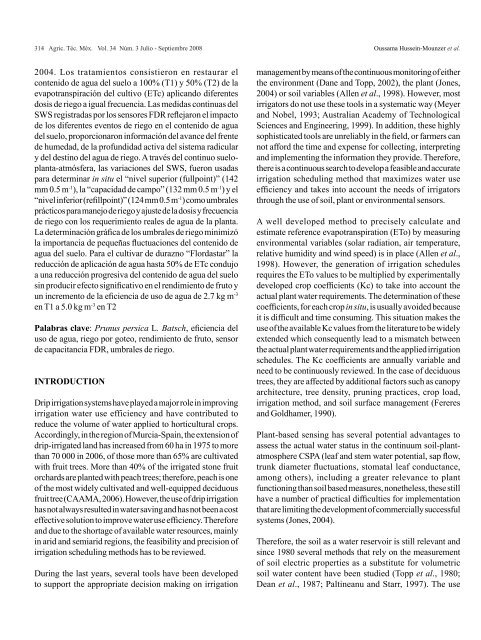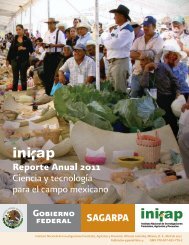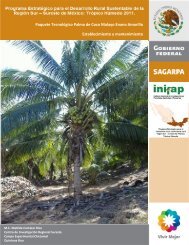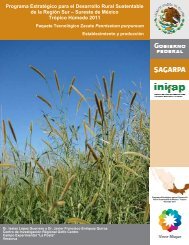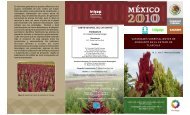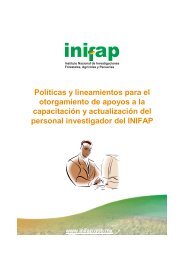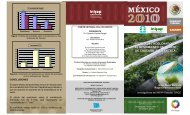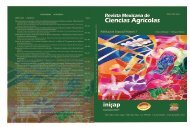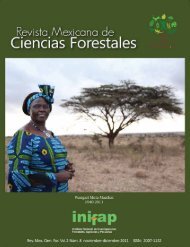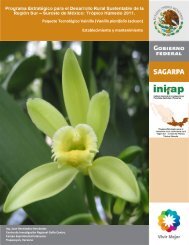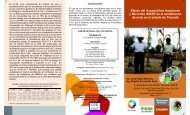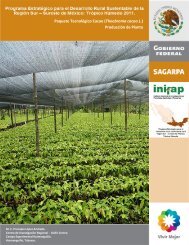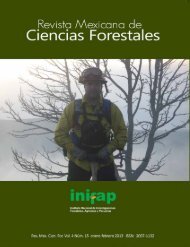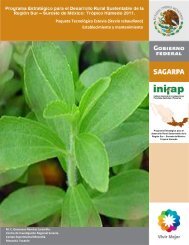Vol. 34 Núm. 3 - Instituto Nacional de Investigaciones Forestales ...
Vol. 34 Núm. 3 - Instituto Nacional de Investigaciones Forestales ...
Vol. 34 Núm. 3 - Instituto Nacional de Investigaciones Forestales ...
Create successful ePaper yourself
Turn your PDF publications into a flip-book with our unique Google optimized e-Paper software.
314 Agric. Téc. Méx. <strong>Vol</strong>. <strong>34</strong> Núm. 3 Julio - Septiembre 2008 Oussama Hussein-Mounzer et al.2004. Los tratamientos consistieron en restaurar elcontenido <strong>de</strong> agua <strong>de</strong>l suelo a 100% (T1) y 50% (T2) <strong>de</strong> laevapotranspiración <strong>de</strong>l cultivo (ETc) aplicando diferentesdosis <strong>de</strong> riego a igual frecuencia. Las medidas continuas <strong>de</strong>lSWS registradas por los sensores FDR reflejaron el impacto<strong>de</strong> los diferentes eventos <strong>de</strong> riego en el contenido <strong>de</strong> agua<strong>de</strong>l suelo, proporcionaron información <strong>de</strong>l avance <strong>de</strong>l frente<strong>de</strong> humedad, <strong>de</strong> la profundidad activa <strong>de</strong>l sistema radiculary <strong>de</strong>l <strong>de</strong>stino <strong>de</strong>l agua <strong>de</strong> riego. A través <strong>de</strong>l continuo sueloplanta-atmósfera,las variaciones <strong>de</strong>l SWS, fueron usadaspara <strong>de</strong>terminar in situ el “nivel superior (fullpoint)” (142mm 0.5 m -1 ), la “capacidad <strong>de</strong> campo” (132 mm 0.5 m -1 ) y el“nivel inferior (refillpoint)” (124 mm 0.5 m -1 ) como umbralesprácticos para manejo <strong>de</strong> riego y ajuste <strong>de</strong> la dosis y frecuencia<strong>de</strong> riego con los requerimiento reales <strong>de</strong> agua <strong>de</strong> la planta.La <strong>de</strong>terminación gráfica <strong>de</strong> los umbrales <strong>de</strong> riego minimizóla importancia <strong>de</strong> pequeñas fluctuaciones <strong>de</strong>l contenido <strong>de</strong>agua <strong>de</strong>l suelo. Para el cultivar <strong>de</strong> durazno “Flordastar” lareducción <strong>de</strong> aplicación <strong>de</strong> agua hasta 50% <strong>de</strong> ETc condujoa una reducción progresiva <strong>de</strong>l contenido <strong>de</strong> agua <strong>de</strong>l suelosin producir efecto significativo en el rendimiento <strong>de</strong> fruto yun incremento <strong>de</strong> la eficiencia <strong>de</strong> uso <strong>de</strong> agua <strong>de</strong> 2.7 kg m -3en T1 a 5.0 kg m -3 en T2Palabras clave: Prunus persica L. Batsch, eficiencia <strong>de</strong>luso <strong>de</strong> agua, riego por goteo, rendimiento <strong>de</strong> fruto, sensor<strong>de</strong> capacitancia FDR, umbrales <strong>de</strong> riego.INTRODUCTIONDrip irrigation systems have played a major role in improvingirrigation water use efficiency and have contributed toreduce the volume of water applied to horticultural crops.Accordingly, in the region of Murcia-Spain, the extension ofdrip-irrigated land has increased from 60 ha in 1975 to morethan 70 000 in 2006, of those more than 65% are cultivatedwith fruit trees. More than 40% of the irrigated stone fruitorchards are planted with peach trees; therefore, peach is oneof the most wi<strong>de</strong>ly cultivated and well-equipped <strong>de</strong>ciduousfruit tree (CAAMA, 2006). However, the use of drip irrigationhas not always resulted in water saving and has not been a costeffective solution to improve water use efficiency. Thereforeand due to the shortage of available water resources, mainlyin arid and semiarid regions, the feasibility and precision ofirrigation scheduling methods has to be reviewed.During the last years, several tools have been <strong>de</strong>velopedto support the appropriate <strong>de</strong>cision making on irrigationmanagement by means of the continuous monitoring of eitherthe environment (Dane and Topp, 2002), the plant (Jones,2004) or soil variables (Allen et al., 1998). However, mostirrigators do not use these tools in a systematic way (Meyerand Nobel, 1993; Australian Aca<strong>de</strong>my of TechnologicalSciences and Engineering, 1999). In addition, these highlysophisticated tools are unreliably in the field, or farmers cannot afford the time and expense for collecting, interpretingand implementing the information they provi<strong>de</strong>. Therefore,there is a continuous search to <strong>de</strong>velop a feasible and accurateirrigation scheduling method that maximizes water useefficiency and takes into account the needs of irrigatorsthrough the use of soil, plant or environmental sensors.A well <strong>de</strong>veloped method to precisely calculate an<strong>de</strong>stimate reference evapotranspiration (ETo) by measuringenvironmental variables (solar radiation, air temperature,relative humidity and wind speed) is in place (Allen et al.,1998). However, the generation of irrigation schedulesrequires the ETo values to be multiplied by experimentally<strong>de</strong>veloped crop coefficients (Kc) to take into account theactual plant water requirements. The <strong>de</strong>termination of thesecoefficients, for each crop in situ, is usually avoi<strong>de</strong>d becauseit is difficult and time consuming. This situation makes theuse of the available Kc values from the literature to be wi<strong>de</strong>lyexten<strong>de</strong>d which consequently lead to a mismatch betweenthe actual plant water requirements and the applied irrigationschedules. The Kc coefficients are annually variable andneed to be continuously reviewed. In the case of <strong>de</strong>ciduoustrees, they are affected by additional factors such as canopyarchitecture, tree <strong>de</strong>nsity, pruning practices, crop load,irrigation method, and soil surface management (Fereresand Goldhamer, 1990).Plant-based sensing has several potential advantages toassess the actual water status in the continuum soil-plantatmosphereCSPA (leaf and stem water potential, sap flow,trunk diameter fluctuations, stomatal leaf conductance,among others), including a greater relevance to plantfunctioning than soil based measures, nonetheless, these stillhave a number of practical difficulties for implementationthat are limiting the <strong>de</strong>velopment of commercially successfulsystems (Jones, 2004).Therefore, the soil as a water reservoir is still relevant andsince 1980 several methods that rely on the measurementof soil electric properties as a substitute for volumetricsoil water content have been studied (Topp et al., 1980;Dean et al., 1987; Paltineanu and Starr, 1997). The use


